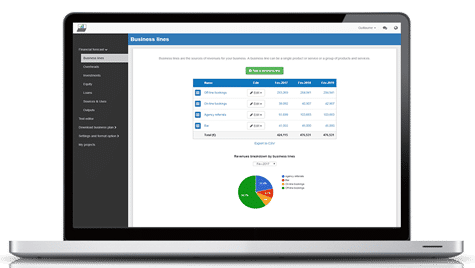How to create a financial forecast for a hotshot trucking company?
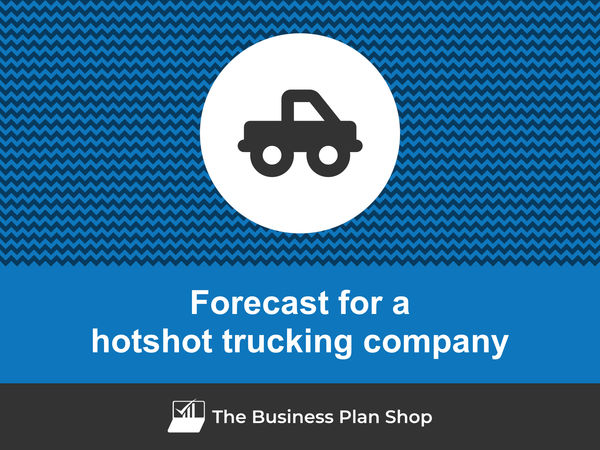
Developing and maintaining an up-to-date financial forecast for your hotshot trucking company is key in order to maintain visibility on your business’s future cash flows.
If you feel overwhelmed at the thought of putting together a hotshot trucking company financial forecast then don’t worry as this guide is here to help you.
We'll cover everything from: the main objectives of a financial forecast, the data you need to gather before starting, to the tables that compose it, and the tools that will help you create and maintain your forecast efficiently.
Let's get started!
Why create and maintain a financial forecast for a hotshot trucking company?
The financial projections for your hotshot trucking company act as a financial blueprint to guide its growth with confidence and ensure its long-term financial viability.
To create them, you will need to look at your business in detail - from sales to operating costs and investments - to assess how much profit it can generate in the years to come and what will be the associated cash flows.
During challenging market conditions, maintaining an up-to-date financial forecast enables early detection of potential financial shortfalls, allowing for timely adjustments or securing financing before facing a cash crisis.
Your hotshot trucking company's financial forecast will also prove invaluable when seeking financing. Banks and investors will undoubtedly request a thorough examination of your financial figures, making precision and presentation essential.
Need a solid financial forecast?
The Business Plan Shop does the maths for you. Simply enter your revenues, costs and investments. Click save and our online tool builds a three-way forecast for you instantly.
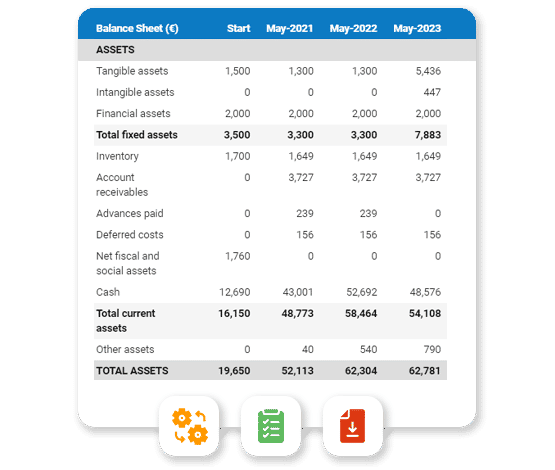
What information is used as input to build a hotshot trucking company financial forecast?
A hotshot trucking company's financial forecast needs to be built on the right foundation: your assumptions.
The data required to create your assumptions will depend on whether you are a new or existing hotshot trucking company.
If you are creating (or updating) the forecast of an existing hotshot trucking company, then your main inputs will be historical accounting data and operating metrics, and your team’s view on what to expect for the next three to five years.
If you are building financial projections for a new hotshot trucking company startup, you will need to rely on market research to form your go-to-market strategy and derive your sales forecast.
For a new venture, you will also need an itemised list of resources needed for the hotshot trucking company to operate, along with a list of equipment required to launch the venture (more on that below).
Now that you understand what is needed, let’s have a look at what elements will make up your hotshot trucking company's financial forecast.
The sales forecast for a hotshot trucking company
From experience, it is usually best to start creating your hotshot trucking company financial forecast by your sales forecast.
To create an accurate sales forecast for your hotshot trucking company, you will have to rely on the data collected in your market research, or if you're running an existing hotshot trucking company, the historical data of the business, to estimate two key variables:
- The average price
- The number of monthly transactions
To get there, you will need to consider the following factors:
- Increased demand for hotshot trucking services due to a rise in e-commerce sales during the holiday season (you may experience a higher average price and number of monthly transactions during this time)
- A shortage of qualified hotshot truck drivers in your area, leading to higher wages and potential delays in deliveries (you may need to adjust your prices and forecast for potential delays)
- New regulations on truck weight limits, affecting the amount of cargo you can transport and potentially increasing your operating costs (you may need to adjust your pricing strategy to account for these changes)
- Emerging competitors in the hotshot trucking industry, offering lower prices and potentially taking away some of your customers (you may need to reassess your pricing strategy and find ways to differentiate your services)
- Unforeseen weather events, such as hurricanes or snowstorms, causing disruptions in your delivery schedule and potentially affecting your monthly transactions (you may need to plan for potential delays and communicate with your customers about any changes)
Once you have an idea of what your future sales will look like, it will be time to work on your overhead budget. Let’s see what this entails.
Need inspiration for your business plan?
The Business Plan Shop has dozens of business plan templates that you can use to get a clear idea of what a complete business plan looks like.

The operating expenses for a hotshot trucking company
Once you know what level of sales you can expect, you can start budgeting the expenses required to operate your hotshot trucking company on a daily basis.
Expenses normally vary based on how much revenue you anticipate (which is why, from experience, it is always better to start your forecast with the topline projection), and where your business is based.
Operating expenses for a hotshot trucking company will include some of the following items:
- Fuel Costs: As a hotshot trucking company, one of your biggest operating expenses will be fuel costs. This includes both diesel fuel for your trucks and gasoline for any company vehicles.
- Vehicle Maintenance: Keeping your trucks in good working condition is crucial for your business. This includes regular oil changes, tire rotations, and any repairs that may be needed.
- Staff Salaries: Your employees are the backbone of your hotshot trucking company. This expense includes salaries for your drivers, dispatchers, and any other staff members.
- Accountancy Fees: As a business owner, it's important to keep your financial records accurate and up-to-date. You may need to hire an accountant to help with bookkeeping, tax preparation, and other financial tasks.
- Insurance Costs: To protect your business and your assets, you'll need to have various types of insurance. This can include commercial auto insurance, liability insurance, and workers' compensation insurance.
- Software Licences: In today's digital age, many hotshot trucking companies use software to help with tasks such as dispatching, invoicing, and tracking shipments. These software licences can be a significant operating expense.
- Banking Fees: As a business, you'll likely have a business bank account and may incur fees for services such as wire transfers, overdraft protection, and ATM usage.
- Permits and Licences: In addition to your business license, you may need to obtain special permits or licences to operate as a hotshot trucking company. These may include a USDOT number, state permits, and other regulatory requirements.
- Toll Fees: If your routes involve toll roads, you'll need to budget for these costs. This can add up quickly, especially if you have multiple trucks on the road.
- Vehicle Registration and Taxes: Each year, you'll need to renew your vehicle registrations and pay various taxes, such as property tax on your trucks.
- Office Expenses: Even if you don't have a physical office, you may still have expenses such as phone and internet service, office supplies, and postage.
- Advertising and Marketing: To attract new customers and grow your business, you may need to invest in advertising and marketing efforts such as website development, social media advertising, and print materials.
- Safety Equipment: As a hotshot trucking company, safety is of utmost importance. You may need to purchase safety equipment such as fire extinguishers, reflective vests, and first aid kits for your trucks and drivers.
- Per Diem and Lodging: If your drivers are on the road for extended periods of time, you'll need to cover the costs of their meals and lodging while they're away from home.
- Training and Certifications: To ensure your drivers are qualified and up-to-date on industry regulations, you may need to provide training and cover the costs of certifications such as hazmat training and commercial driver's license renewals.
This list will need to be tailored to the specificities of your hotshot trucking company, but should offer a good starting point for your budget.
What investments are needed to start or grow a hotshot trucking company?
Creating and expanding a hotshot trucking company also requires investments which you need to factor into your financial forecast.
Capital expenditures and initial working capital items for a hotshot trucking company could include elements such as:
- Truck and trailer purchases: As a hotshot trucking company, your main assets are your trucks and trailers. These are necessary for transporting goods and materials for your clients. You may need to purchase new or used trucks and trailers to expand your fleet or replace old ones.
- Equipment and tool upgrades: Along with your trucks and trailers, you also need various equipment and tools to operate your business efficiently. This may include GPS systems, load securement equipment, tarps, and other tools that are specific to hotshot trucking. Upgrading or purchasing new equipment can improve your operations and increase your profitability.
- Maintenance and repairs: As with any type of vehicle, regular maintenance and occasional repairs are necessary for your trucks and trailers. These costs can add up, especially if you have a large fleet. It's important to include these expenses in your expenditure forecast to ensure that you have enough funds to keep your vehicles in good working condition.
- Office and warehouse space: While hotshot trucking companies may not have a traditional office, you may still need a space to store paperwork, meet with clients, or conduct administrative tasks. Additionally, you may need a warehouse or storage space to keep goods and materials for your clients. These expenses can be significant, especially if you need a larger space as your business grows.
- Technology and software: In today's digital age, technology and software are essential for running a successful hotshot trucking company. This may include software for dispatching, tracking shipments, and managing finances. You may also need to invest in hardware such as computers and printers. Keeping up with technology advancements can give your business a competitive edge, but it also comes with a cost.
Again, this list is not exhaustive and will need to be adjusted according to the circumstances of your hotshot trucking company.
Need a convincing business plan?
The Business Plan Shop makes it easy to create a financial forecast to assess the potential profitability of your projects, and write a business plan that’ll wow investors.
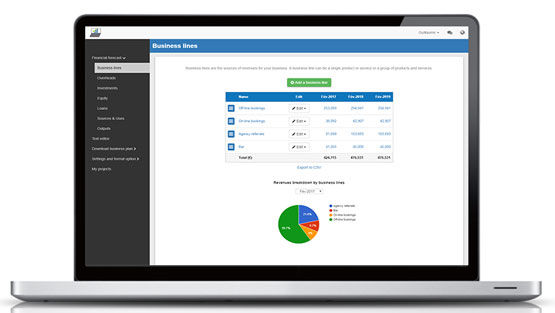
The financing plan of your hotshot trucking company
The next step in the creation of your financial forecast for your hotshot trucking company is to think about how you might finance your business.
You will have to assess how much capital will come from shareholders (equity) and how much can be secured through banks.
Bank loans will have to be modelled so that you can separate the interest expenses from the repayments of principal, and include all this data in your forecast.
Issuing share capital and obtaining a bank loan are two of the most common ways that entrepreneurs finance their businesses.
What tables compose the financial plan for a hotshot trucking company?
Now let's have a look at the main output tables of your hotshot trucking company's financial forecast.
The forecasted profit & loss statement
The profit & loss forecast gives you a clear picture of your business’ expected growth over the first three to five years, and whether it’s likely to be profitable or not.
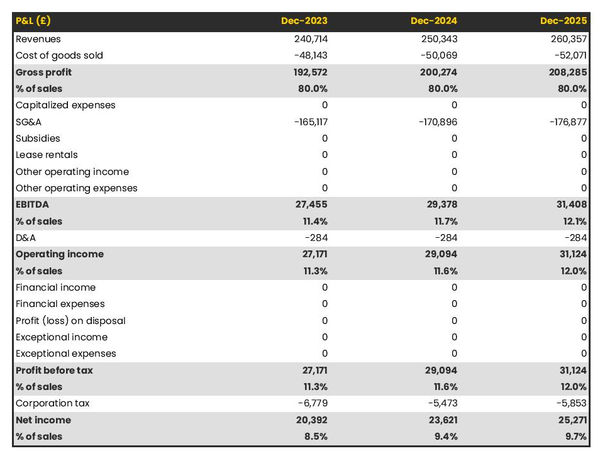
A healthy hotshot trucking company's P&L statement should show:
- Sales growing at (minimum) or above (better) inflation
- Stable (minimum) or expanding (better) profit margins
- A healthy level of net profitability
This will of course depend on the stage of your business: numbers for an established hotshot trucking company will look different than for a startup.
The projected balance sheet
Your hotshot trucking company's forecasted balance sheet enables you to assess your financial structure and working capital requirements.
It is composed of three types of elements: assets, liabilities and equity:
- Assets: represent what the business owns and uses to produce cash flows. It includes resources such as cash, equipment, and accounts receivable (money owed by clients).
- Liabilities: represent funds advanced to the business by lenders and other creditors. It includes items such as accounts payable (money owed to suppliers), taxes due and loans.
- Equity: is the combination of what has been invested by the business owners and the cumulative profits and losses generated by the business to date (which are called retained earnings). Equity is a proxy for the value of the owner's stake in the business.

The cash flow projection
The cash flow forecast of your hotshot trucking company will show how much cash the business is expected to generate or consume over the next three to five years.
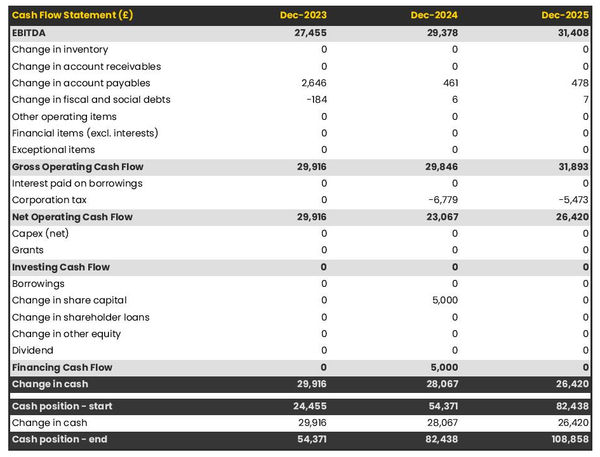
There are multiple ways of presenting a cash flow forecast but from experience, it is better to organise it by nature in order to clearly show these elements:
- Operating cash flow: how much cash is generated by the hotshot trucking company's operations
- Investing cash flow: what is the business investing to expand or maintain its equipment
- Financing cash flow: is the business raising additional funds or repaying financiers (debt repayment, dividends)
Your cash flow forecast is the most important element of your overall financial projection and that’s where you should focus your attention to ensure that your hotshot trucking company is adequately funded.
Note: if you are preparing a financial forecast in order to try to secure funding, you will need to include both a yearly and monthly cash flow forecast in your hotshot trucking company's financial plan.
Need a solid financial forecast?
The Business Plan Shop does the maths for you. Simply enter your revenues, costs and investments. Click save and our online tool builds a three-way forecast for you instantly.

Which tool should you use to create your hotshot trucking company's financial forecast?
Creating your hotshot trucking company's financial forecast may sound fairly daunting, but the good news is that there are several ways to go about it.
Using online financial forecasting software to build your hotshot trucking company's projections
The modern and easiest way is to use professional online financial forecasting software such as the one we offer at The Business Plan Shop.
There are several advantages to using specialised software:
- You can easily create your financial forecast by letting the software take care of the financial calculations for you without errors
- You have access to complete financial forecast templates
- You get a complete financial forecast ready to be sent to your bank or investors
- You can easily track your actual financial performance against your financial forecast, and recalibrate your forecast as the year goes by
- You can create scenarios to stress test your forecast's main assumptions
- You can easily update your forecast as time goes by to maintain visibility on future cash flows
- You have a friendly support team on standby to assist you when you are stuck
- It’s cost-efficient and much cheaper than using an accountant or consultant (see below)
If you are interested in this type of solution, you can try our forecasting software for free by signing up here.
Calling in a financial consultant or chartered accountant
Outsourcing the creation of your hotshot trucking company financial forecast is another possible solution.
This will cost more than using software as you can expect as your price will have to cover the accountant’s time, software cost, and profit margin.
Price can vary greatly based on the complexity of your business. For a small business, from experience, a simple three-year financial forecast (including a balance sheet, income statement, and cash flow statement) will start at around £700 or $1,000.
Bear in mind that this is for forecasts produced at a single point in time, updating or tracking your forecast against actuals will cost extra.
If you decide to outsource your forecasting:
- Make sure the professional has direct experience in your industry and is able to challenge your assumptions constructively.
- Steer away from consultants using sectorial ratios to build their client’s financial forecasts (these projections are worthless for a small business).
Why not use a spreadsheet such as Excel or Google Sheets to build your hotshot trucking company's financial forecast?
Creating an accurate and error-free hotshot trucking company financial forecast on Excel (or any spreadsheet) is very technical and requires both a strong grasp of accounting principles and solid skills in financial modelling.
Most entrepreneurs lack the expertise required to create an accurate financial forecast using spreadsheet software like Excel or Google Sheets. As a result, it is unlikely anyone will trust your numbers.
The second reason is that it is inefficient. Building forecasts on spreadsheets was the only option in the 1990s and early 2000s, nowadays technology has advanced and software can do it much faster and much more accurately.
This is why professional forecasters all use software. With the rise of AI, software is also becoming smarter at helping us detect mistakes in our forecasts and helping us analyse the numbers to make better decisions.
Finally, like everything with spreadsheets, tracking actuals vs. forecasts and updating your forecast as the year progresses is manual, tedious, error-prone, and time-consuming. Whereas financial forecasting software like The Business Plan Shop is built for this.
Need a convincing business plan?
The Business Plan Shop makes it easy to create a financial forecast to assess the potential profitability of your projects, and write a business plan that’ll wow investors.

Use our financial forecast templates for inspiration
The Business Plan Shop has dozens of financial forecast examples available.
Our templates contain both a financial forecast and a written business plan which presents, in detail, the company, the team, the strategy, and the medium-term objectives.
Our templates are a great source of inspiration, whether you just want to see what a complete business plan looks like, or are looking for concrete examples of how you should model financial elements in your own forecast.
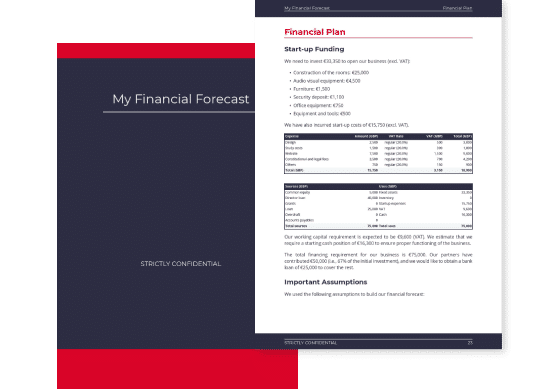
Takeaways
- A financial projection shows expected growth, profitability, and cash generation for your business over the next three to five years.
- Tracking actuals vs. forecast and keeping your financial forecast up-to-date is the only way to maintain visibility on future cash flows.
- Using financial forecasting software makes it easy to create and maintain up-to-date projections for your hotshot trucking company.
You have reached the end of our guide. We hope you now have a better understanding of how to create a financial forecast for a hotshot trucking company. Don't hesitate to contact our team if you have any questions or want to share your experience building forecasts!
Need inspiration for your business plan?
The Business Plan Shop has dozens of business plan templates that you can use to get a clear idea of what a complete business plan looks like.

Also on The Business Plan Shop
Know someone who runs or wants to start a hotshot trucking company? Share our financial projection guide with them!

